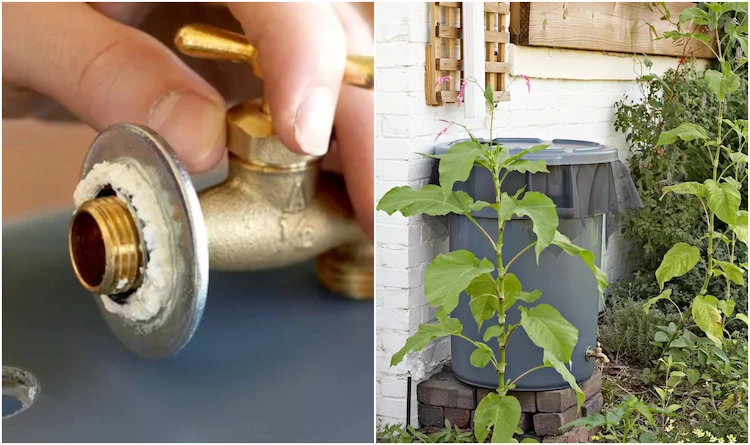Nowadays we have started to live and think sustainably. If we save the natural resources, we can create a better and sustainable environment for ourselves and our families. Saving water is a good idea for every household and for every garden. You can use a rain barrel to catch and store the water until you need it. And how to build your own rain barrel yourself, you will learn from this article!
Build a rain barrel yourself: materials required
It’s probably easier than you think to build your own water butt by repurposing an inexpensive plastic trash can with a lid for outdoor use. Here is the list of tools and materials needed:
1 plastic trash can with a lid (the bigger it is, the more water you can hold)
1 brass tap
1 tube of waterproof sealant
1 Rolle Teflonband
1 pipe fitting
drill and drill
Carpet knife or utility knife
Landscape gardening fabric or fine mesh screen
Follow step-by-step instructions

It is easy to build a water butt yourself using our instructions.
- First choose your location. For a rain barrel to work properly, it should be placed near the corner of your home where your drainpipe runs down the gutter. You need to route the drainpipe into the rain barrel to filter the water from the gutter. So choose a corner of your home that has a drainpipe to place your water butt.
- Drill a hole a few inches off the bottom of your garbage can. This is where you will insert the tap. Use a drill that is slightly smaller than or the same size as the nozzle or fitting (according to the size of the nozzle).
- Place a metal washer on the threaded end of the spigot and then place a snug rubber washer over the threads to hold the washer in place and prevent leakage. Apply waterproof caulk to the rubber seal and insert the spigot into the hole on the outside wall of the keg. Allow the sealant to dry, then slide a rubber washer, then a metal washer, onto the spigot threads inside the barrel. Alternatively, you can insert the tube fitting piece into the drilled hole, leaving a small gap. Apply sealant to the fitting and then tighten it onto the barrel. Apply more sealant to the fitting nut and screw the fitting into the dustbin. Let the sealant dry. Wrap the threads of the nozzle with Teflon tape and screw the nozzle into the fitting on the outside of the bin.

- Carefully cut a hole in the lid of your water butt. This hole should be under your home’s downspout so the water will flow straight into the barrel. Cut the hole large enough to accommodate the flow of water from the downspout. You should also drill a few holes near the top of the rain barrel. These holes allow the water to overflow if necessary.
- Tip for the test garden: You can run a short piece of hose or PVC pipe from the overflow opening to another water butt to connect them. When your first water butt is full, the excess water flows into the next water butt and you don’t lose overflow water.
- Cut a piece of landscaping fabric or a privacy screen that overhangs the top by at least a few inches. Then slide the lid over to secure and trim off the excess fabric or screen. This creates a barrier that prevents mosquitoes and other creatures from getting into the water in your rain barrel. It also prevents dirt washed off the roof from getting into the water.
- Place your self-made water butt directly under a downspout, where you can best reach the tap. It is best to place your water butt on a stable platform, e.g. B. a low stack of bricks or concrete blocks. This way the water will be squeezed out better by gravity if you connect a hose to the tap. The extra height also makes it easier to fill watering cans right at the tap. Then all you have to do is wait for the rain and enjoy the water (and money) savings.